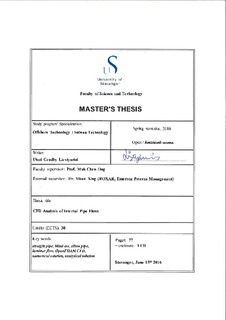| dc.description.abstract | The process piping in the refinery plant does not always have straight pipe geometry. The configuration of
these pipelines are usually zigzag or snake-like. The pipe fittings or joints including elbow pipes, blind-tee
pipes, T-pipes, Y-pipes are found to be common in a refinery. One of the reasons why the pipelines are
layed in zigzag or snake-like configuration is because of the limited space for the piping equipment even in
the largest refineries.
The aim of the thesis is to study the physical flow inside a pipe with focus on blind-tee and elbow pipes.
Laminar flow regime with Reynolds number equals to 1000 is investigated in this study. The analysis
utilizes CFD numerical simulations by using OpenFOAM to investigate the physical flow inside the studied
pipes. The geometry of the pipes which are used in this study have a diameter (D) of 1 m, and the blind-tee
length varied from 1D to 5D. In order to achieve the main objective, there are sub-objectives which need
to be carried out. First, the laminar flow analysis of the straight pipe with a length 10D is investigated as
the base case of the study. Since the straight pipe is installed before and after the pipe joints in order to
attain the fully developed desirable flow profile. Second, the geometry and mesh setup of the studied pipes
are created by using Autodesk Inventor, GMSH and SALOME Software, starting with the straight pipe,
and then followed by the blind-tee and elbow pipe. Third, the numerical analysis is carried out by
performing OpenFOAM CFD simulations. Fourth, the sensitivity studies of different mesh elements, timesteps,
and Reynolds number are carried out. Last, the results of the velocity profiles obtained from the
numerical simulations are validated with the velocity profiles of laminar flow derived from the analytical
solution of classical formula.
Three-dimensional numerical simulations of fluid flow in the straight pipe, blind-tee, and elbow pipe are
presented. In addition, the streamline, velocity contour, and pressure contour of the blind-tee and elbow
pipe cases are shown. For the straight pipe case, the velocity profile in the pipe agrees well with the
analytical solution of classical formula. For the blind-tee and elbow pipe cases, the velocity profile at the
5D from the inlet and 5D from the outlet have been checked for grid convergence studies. It is found that
there are flow circulations, which occurs inside the blind-tee. Moreover, for the blind-tee with the tee
lengths that are equal to 4D and 5D, fluid deposits would very likely occur, since the velocity inside this
tee is very low. | nb_NO |
